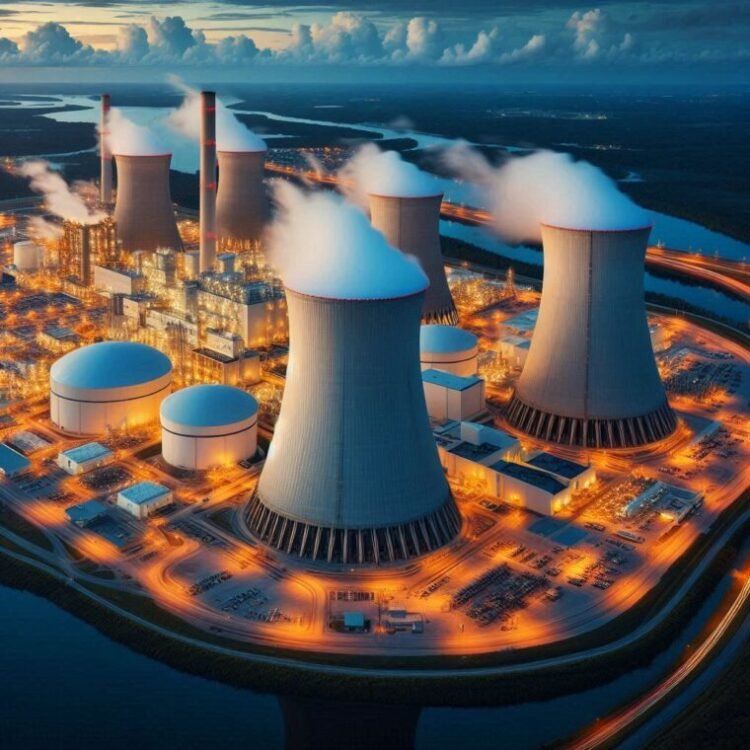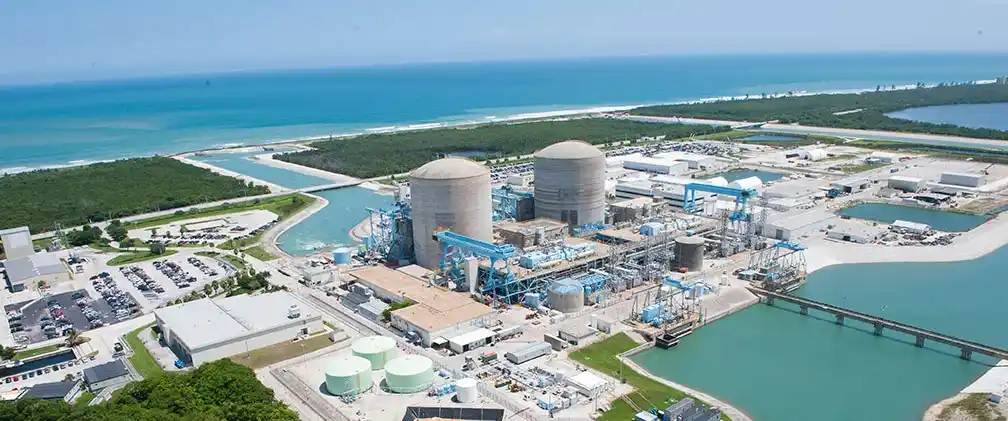Florida is home to several prominent nuclear power plants that play a crucial role in providing clean and efficient energy to the state. Here are the top 5 nuclear power plants in Florida, each known for its significant contribution to the energy sector.

1. Turkey Point Nuclear Generating Station
The Turkey Point Nuclear Generating Station is a nuclear and gas-fired power plant located on a 3,300-acre (1,300 ha) site two miles east of Homestead, Florida, United States, next to Biscayne National Park located about 25 miles (40 km) south of Miami, Florida near the southernmost edge of Miami-Dade County. The facility is owned by Florida Power & Light.

Here’s a more detailed look at Turkey Point Nuclear Generating Station:
- Units: 2 (Pressurized Water Reactors)
- Capacity: 1,800 Megawatts (MW)
- Owner: Florida Power & Light Company
- Started Commercial Operation: Unit 3 (1972), Unit 4 (1973)
Turkey Point Nuclear Generating Station boasts two operational pressurized water reactors, providing a significant chunk of Florida’s electricity. Located near Miami, it’s the largest nuclear power plant in the state.
The Turkey Point site also houses a natural gas-fired combined cycle unit, which began operating in 2007. This unit adds an additional 1,150 megawatts of capacity to the plant.
2. St. Lucie Nuclear Power Plant

The St. Lucie Nuclear Power Plant, situated on Hutchinson Island east of Fort Pierce, Florida, is a vital contributor to the state’s energy infrastructure. Here’s a breakdown of this twin-reactor powerhouse:
- Location: Hutchinson Island, Florida (St. Lucie County)
- Units: 2 (Pressurized Water Reactors)
- Capacity: 1,870 Megawatts (MW)
- Owner: Florida Power & Light Company
- Started Commercial Operation: Unit 1 (1976), Unit 2 (1983)
The St. Lucie Nuclear Power Plant stands as the second-largest nuclear facility in Florida, generating enough clean energy to power over a million homes.
Technical Details
Both units at St. Lucie utilize pressurized water reactors (PWRs). In a PWR, uranium fuel generates heat, which is transferred to water in a closed loop. This hot water doesn’t come into contact with the water that produces steam to spin the turbines. Instead, it heats a secondary loop containing water at a lower pressure, which then boils into steam to drive the turbines and generate electricity. This design feature helps to prevent radioactive contamination of the water used for steam generation.
Environmental Impact
One of the significant advantages of St. Lucie is its minimal greenhouse gas emissions during electricity generation. This makes it a crucial player in Florida’s clean energy mix.
Emergency Preparedness
The surrounding communities are prepared for any potential emergencies through comprehensive plans and public education initiatives. Regular drills and exercises ensure a well-coordinated response system in place.
The Future of St. Lucie
The operating licenses for both St. Lucie units have been extended, with Unit 1 running until 2036 and Unit 2 reaching its expiration date in 2043. Public discussions regarding the future of the plant beyond these dates are likely to take place as they approach.
3. Crystal River Nuclear Power Plant (Unit 3 – Decommissioned)
The Crystal River Nuclear Power Plant, unlike the previously mentioned stations, has a different story to tell. Once a contributor to Florida’s energy needs, it’s now a decommissioning project.

History of Crystal River
Located in Citrus County, Florida, the Crystal River Nuclear Power Plant housed a single pressurized water reactor. Here’s a quick recap of its past:
- Units: 1 (Pressurized Water Reactor – Decommissioned)
- Capacity: 860 Megawatts (MW)
- Owner: Duke Energy Florida
- Started Commercial Operation: 1979 (Shut down in 2013)
The plant began generating electricity in 1979. However, its operation came to an end in 2013 following a significant containment building crack. The Decommissioning efforts officially began in 2019.
Decommissioning Process
Decommissioning refers to the safe and gradual dismantling of a nuclear power plant. It’s a complex undertaking that can take many years to complete. In the case of Crystal River, the process is expected to last for approximately 60 years.
During decommissioning, the radioactive materials are removed from the site and disposed of in federally approved repositories. The remaining structures are then decontaminated and demolished.
Crystal River Energy Complex
It’s important to note that the Crystal River site encompasses more than just the decommissioned nuclear plant. The Crystal River Energy Complex also houses operational natural gas and oil-fired units that continue to generate electricity for the region.
The Future of the Crystal River Site
The future of the Crystal River site remains uncertain. Once decommissioning is complete, the land could be used for other purposes. However, there are no definitive plans in place at this time.
4. Levy Nuclear Power Plant (Construction Canceled)
The Levy Nuclear Power Plant was a proposed two-unit nuclear power plant in Levy County, Florida. However, due to economic reasons and concerns following the Fukushima Daiichi nuclear disaster in Japan, construction was canceled in 2*13. The partially built structures remain on the site.

Here’s a quick look at the Levy Nuclear Power Plant project:
- Location: Levy County, Florida
- Units: 2 (Planned – Construction Canceled)
- Capacity: 2,200 Megawatts (MW)
- Owner: Duke Energy Florida (License Withdrawn)
- Planned Start of Construction: 2009 (Canceled in 2013)
The Levy County site was chosen due to several factors, including:
- Availability of land and water: The site provided sufficient space for the plant and the necessary cooling systems.
- Transmission infrastructure: Existing transmission lines were nearby to carry the generated electricity to the grid.
- Geology: The area had a low risk of earthquakes and other geological hazards.
However, the project faced significant challenges throughout its planning and permitting process.
- Rising Costs: The estimated construction costs for the Levy Nuclear Power Plant ballooned significantly from initial projections.
- Fukushima Disaster: The Fukushima Daiichi nuclear disaster in Japan in 2011 raised public concerns about the safety of nuclear power.
- Regulatory Delays: The project encountered delays in obtaining necessary permits and approvals from regulatory agencies.
Due to these challenges, Duke Energy Florida ultimately decided to cancel the project in 2013. The partially built structures remain on the site, and the future use of the land is uncertain.
5. Vogtle Electric Generating Plant (Units 3 & 4 – Under Construction)
The Vogtle Electric Generating Plant, located across the border in Burke County, Georgia, holds the distinction of being both the closest nuclear power plant to Florida and one of the most recent nuclear facilities to be constructed in the United States. Units 3 and 4 are groundbreaking additions to the plant.

Project Details
- Location: Burke County, Georgia (Borders Florida)
- Units: 2 (AP1000 Pressurized Water Reactors)
- Capacity: 1,150 Megawatts (MW) per unit
- Owner: Georgia Power (co-owners include Oglethorpe Power, Municipal Electric Authority of Georgia, Jacksonville Electric Authority)
- Started Commercial Operation: Unit 3 (July 2023), Unit 4 (April 2024)
Pioneering AP1000 Reactors
Unlike the previously discussed nuclear plants in Florida, Vogtle utilizes a next-generation reactor design – the AP1000. These reactors incorporate several advanced safety features, including:
- Simplified design: Compared to older reactor models, the AP1000 has a smaller footprint and a more streamlined design, potentially reducing the risk of human error.
- Passive safety systems: Certain safety systems within the AP1000 rely on natural processes, such as gravity, to cool the reactor core in case of an emergency. This reduces dependence on mechanical pumps and external power sources.
- Containment improvements: The containment structure surrounding the reactor core is designed to withstand higher pressures and temperatures, offering an additional layer of protection.
Significance for Florida
While situated in Georgia, Vogtle Electric Generating Plant plays a crucial role in meeting Florida’s energy demands. Both Unit 3 and Unit 4 are now operational, contributing a significant amount of clean baseload power to the state.
The Future of Nuclear Power
The Vogtle project serves as a significant development in the ongoing debate about nuclear power in the United States. The successful construction of these next-generation reactors could pave the way for the expansion of nuclear energy as a clean and reliable power source. However, questions regarding long-term waste disposal and the overall economics of nuclear power generation remain topics for discussion.
Comparison of Top 5 Nuclear Power Plants in Florida
| Plant Name | Location | Number of Reactors | Megawatts Generated | Status |
|---|---|---|---|---|
| Turkey Point Nuclear Generating Station | Homestead | 2 | 1,500 | Operational |
| St. Lucie Nuclear Power Plant | Hutchinson Island | 2 | 1,800 | Operational |
| Crystal River Nuclear Plant | Citrus County | 1 | 860 | Decommissioning |
| Port St. Lucie Nuclear Plant | St. Lucie | 2 | 2,200 | Canceled |
| Vogtle Electric Generating Plant | New Hampshire | 1 | 1150 | Operational |
Conclusion
Florida’s nuclear power plants are essential in providing reliable, clean energy to the state. These top five plants showcase the importance of nuclear power in meeting the growing energy demands while minimizing environmental impact.


































